"But certainly the laser proved to be what I realized it was going to be. At that moment in my life I was too ignorant in business law to be able to do it right, and if I did it over again probably the same damn thing would happen." -Gordon Gould, inventor of the laser
You're used to the iconic image of an observatory's dome surrounded by a dark sky. From within, a telescope peers up at the heavens. And with a huge amount of light-gathering power that dwarfs a fully dilated human eye, we can use this tremendous tool to peek into the dark depths of the Universe.
 Image credit: Fort Lewis College Observatory, via http://www.fortlewis.edu/.
Image credit: Fort Lewis College Observatory, via http://www.fortlewis.edu/.
Size is a big deal in astronomy: if you double the diameter of your telescope, you quadruple your light gathering power. Still, size isn't everything. Nearly a century ago, Edwin Hubble was using the famed 100-inch Hooker telescope on Mt. Wilson. Along with the latest in photographic techniques, he was taking images like this one, in which he discovered that Andromeda -- the galaxy in the picture -- lay far beyond our Milky Way. That was back in 1923.
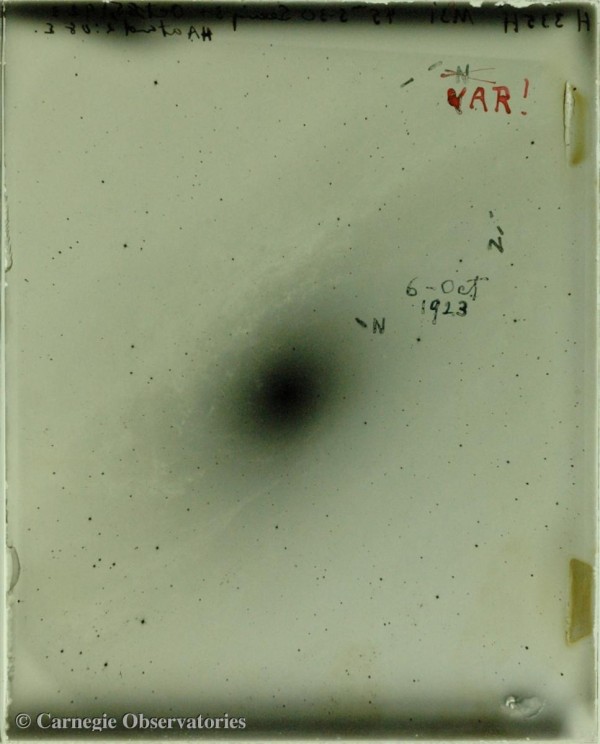 Image credit: Carnegie Observatories, via http://obs.carnegiescience.edu/.
Image credit: Carnegie Observatories, via http://obs.carnegiescience.edu/.
But size isn't everything. Nearly a century later, the largest optical telescopes are only about four times the diameter of the telescope Hubble was using a century ago, and there are only a handful that large. Even the Hubble Space Telescope -- the greatest telescope of our generation -- is smaller than that 100-inch relic! Yet, when the Hubble telescope takes a look at a galaxy nearly 100 times as distant as Andromeda, it can make it out in far greater detail than Edwin Hubble could ever see looking at any galaxy, and in fact was able to resolve individual stars in there.
That's because of two reasons: first off, there have been huge advances in optical systems. Photographic plates have been replaced with charge-coupled devices (CCDs), analog equipment has been replaced by digital, and photons can be counted one-at-a-time. In short, a hobbyist today -- for just a few thousand dollars -- can do better science than the most advanced professionals could -- with equipment ten times the size -- a century ago. But the second reason the Hubble Space Telescope is so fantastic is its location: it's in space!
For astronomy, this is a huge, huge advantage. Here on Earth, the simplest way to tell a planet from a star in the night sky is to look at it for a while, and watch and see whether it twinkles or not. If it doesn't twinkle, it's probably a planet; only stars twinkle in the night sky.
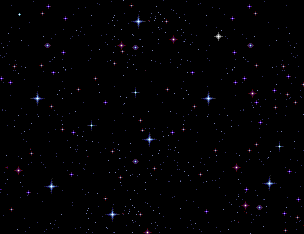 Image credit: retrieved from Astro Bob of http://astrobob.areavoices.com/.
Image credit: retrieved from Astro Bob of http://astrobob.areavoices.com/.
The first humans to see a star (other than the Sun) not twinkle in the sky were the first humans to travel to outer space: from the vantage point of anyone -- human or telescope -- it's only the effects of the atmosphere that cause that twinkling. In reality, that star is fixed in the sky, and it shouldn't matter whether you're on the surface of the Earth or hundreds of miles (or kilometers) above it. But our atmosphere is a turbulent entity, with gases rising and falling, and swooping past rapidly, from any point of view, in stratified layers.
But if you've ever seen a photo like this -- of an observatory shooting a yellow-orange laser into the night sky -- this is our attempt to compensate for the atmosphere. What we're actually doing is nothing short of brilliant.
The laser used here on these observatories takes advantage of a special property of our atmosphere: certain elements are segregated from others at specific altitudes. One of the elements that's very rare is sodium, which happens to be concentrated in a thin layer about 100 km (60 miles) up. If you fire a sodium laser into the air, it will excite those sodium atoms found at that particular altitude, which then spontaneously de-excite, creating an artificial light source to be used as a guide star.
The light from this artificial star then travels back to the telescope through that 100 km of atmosphere, and gets distorted by that same turbulent air column that all the other light coming to your telescope must pass through. Only this time, we know for absolute certain that this should be a single, point source of a particular wavelength at a particular location. So no matter what the light that we actually get back from that artificial star looks like, we know what it should look like: that single point source.
So what do we do? We adapt.
We can compute exactly what the shape of a mirror would need to be -- at any instant -- to undo the turbulent effects of the atmosphere, and return our artificial guide star to simply being a single point of light at the correct location. What we then do is we delay the light from all the other sources coming into the telescope, and actually mechanically adapt a mirror along the light path to be the exact shape it needs to be to undo the effect of the atmosphere, which we then pass the delayed light through.
We update the shape of this mirror on a continuous basis, and this allows us to obtain -- to the best of our ability -- an image that undoes all the negative effects of the atmosphere. This entire setup is the most advanced technique in the field known as adaptive optics, and it's perhaps the most spectacular, revolutionary advance in ground-based astronomy since the invention of photography. Here's a lovely video from Gemini Observatory, detailing how the entire process works.
Click on the above image for a comparison, or the one below to see the same region of the sky -- side-by-side -- with Hubble's data on the left and Gemini's (with the new adaptive optics) on the right.
That was a view of the interior of globular cluster NGC 288, but adaptive optics system on the Keck, Gemini and Lick observatories now routinely performs comparably to telescopes like Hubble that don't even have to contend with the atmosphere! It's allowed us, for example, to look inside the Orion Nebula like never before.
So the next time you see an observatory (or even an image of one) shooting a laser up at the Universe, there's no need to pretend we're fighting aliens, attacking a distant civilization, or beaming energy to a distant location.
As is often the case with science, we're actually doing something much more spectacular: we're using our best technology, to the best of our abilities, to get the resolution of a space-based observatory, all without leaving the Earth!

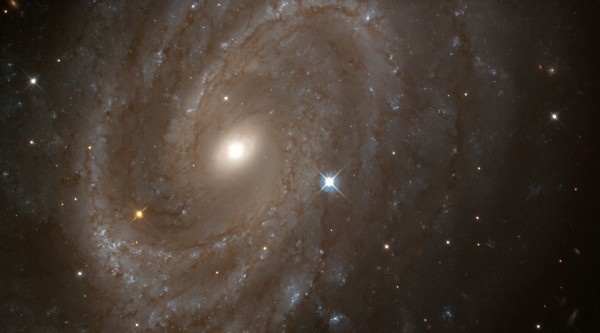
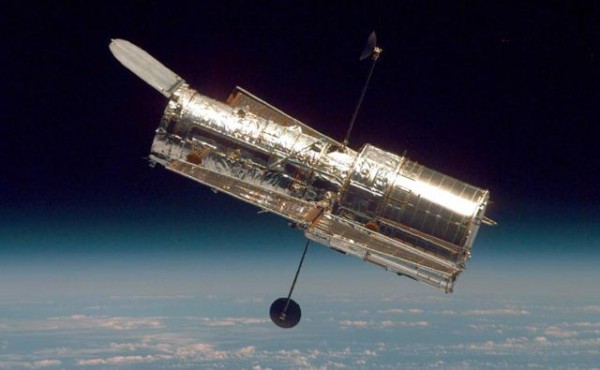
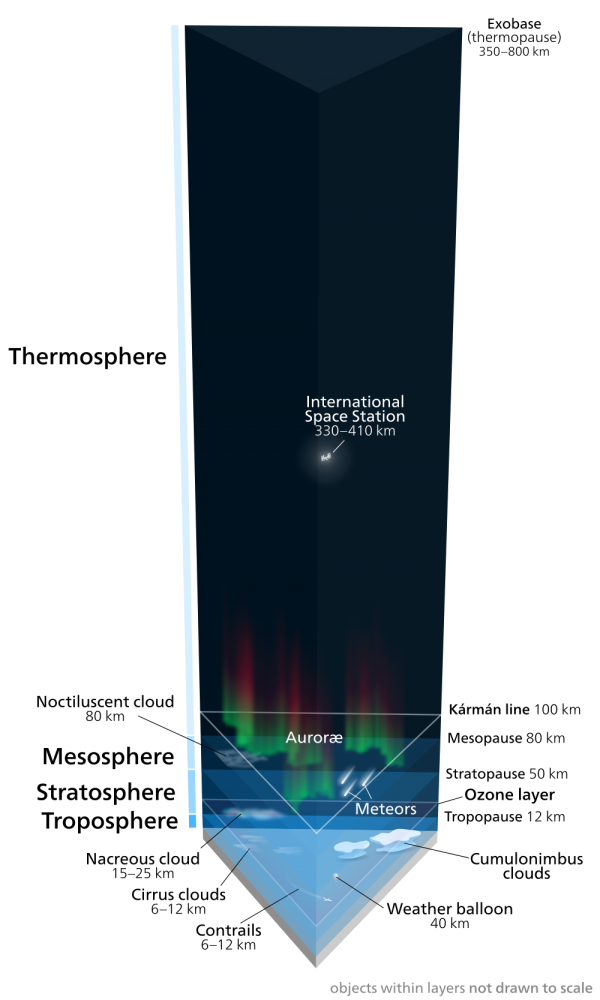
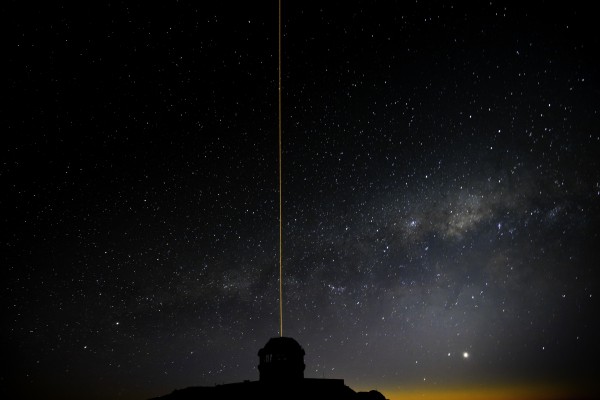
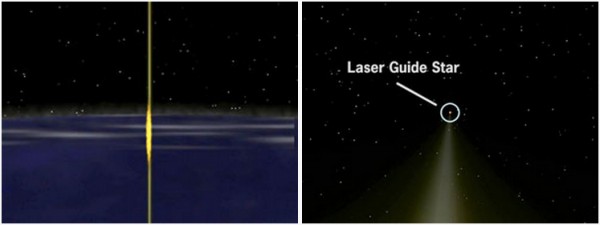

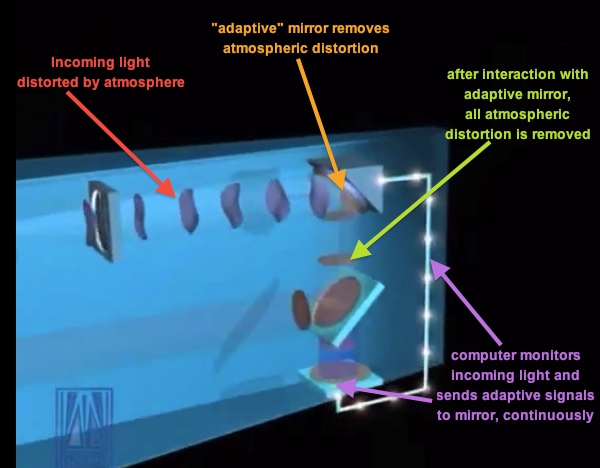
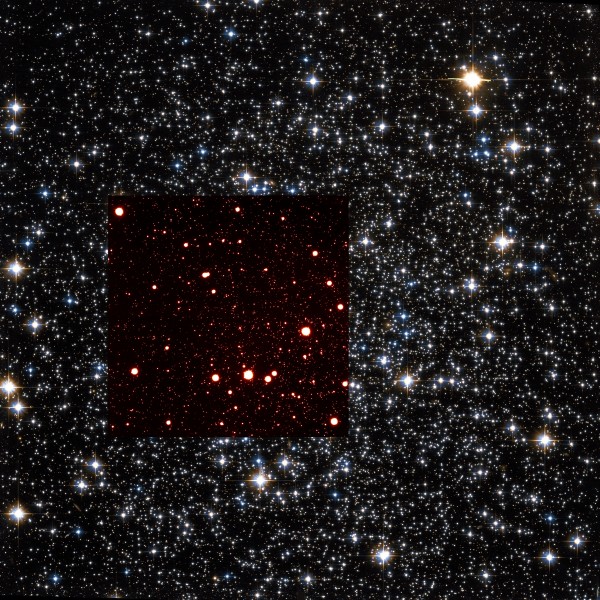
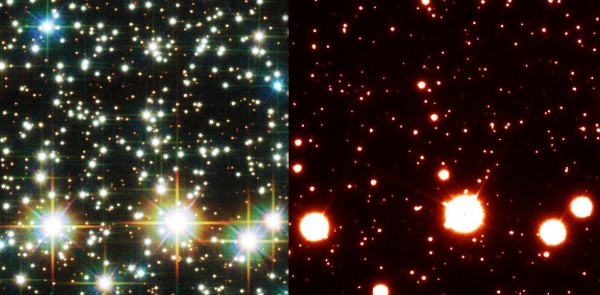

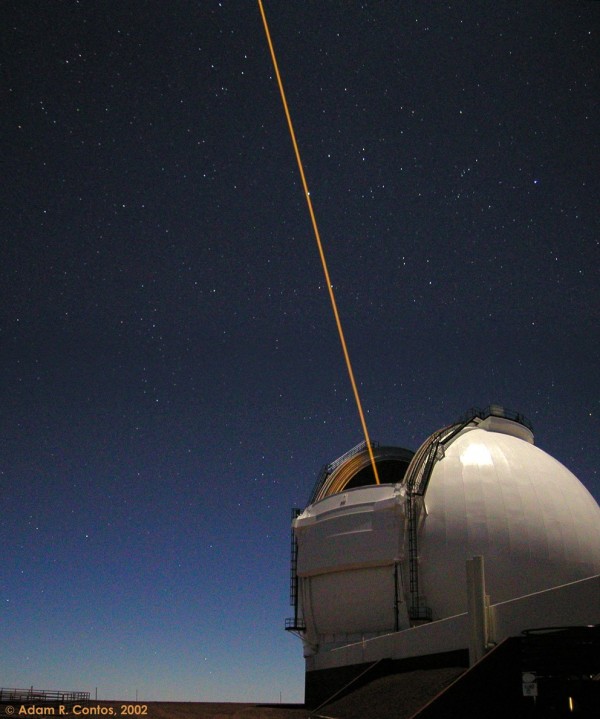
I really appreciated this explanation of adaptive optics. I had no idea how this was implemented but I knew the results were of amazing quality. I understand that, as wondrous as this is, it cannot do the long exposures that the Hubble is known for. I wonder if an adaptive optics installation at a polar location could accomplish a "deep field" image. I am assuming the adaptive corrections are continuous. Is that correct?
Clearly, we need a much bigger space telescope...
That was interesting and informative. I didn't know adaptive optics could provide a better image than Hubble.
"What we then do is we delay the light from all the other sources coming into the telescope" How does that happen exactly? I cant imagine a device in the telescope to delay the light from all the sources of the sky except the laser guide star.
And also something else. I am not sure, but I thought the laser guide star is only used if there is no bright enough star in the field of view of the wave front sensing CCDs (the detectors measuring the distortion of the sky). So the laser is not really necessary to do adaptive optics, its just necessary if you stare at a particular empty part of the sky.
As if reasons were needed.
Very cool. Another illustration of what software can do for us. Whoever thought this up is brilliant.
Why in the world is there a layer of sodium in our atmosphere? How weird.
A bit of historical context. The use of a laser guide star using the sodium layer to correct for atmospheric distortions was invented by Will Happer (Princeton) and others in the early to mid '80s and was a highly classified program within the Strategic Defense Initiative (SDI) for many years. It eventually was unclassified and became a "dual use" technology.
Summat to remember: the reason why ground scopes do better than hubble is because they're a shedload larger than hubble's.
If you use a mirror the same size, your image would be *no better than* Hubble with the best adaptive optics.
But when your ground mirror is 8x the size, your diffraction limit and light collection abilities are better. Getting 75% as good mean you're still 6x better off...
Just a minor point, but its not true that "only stars twinkle" - planets twinkle as well, just to a lesser degree. You can check this out for yourselves by looking at Venus at the moment, very prominent in the west just after sunset. When Venus is low in the sky (say 10 degrees above the horizon) it twinkles pretty impressively.
Wonderful post (as usual). Thanks
Gordon Gould, was not the 'inventor of the laser'. It was a reversed engineered technology from the Roswell crash. Colonel Philip J. Corso (Ret.), a member of President Eisenhower's National Security Council and former head of the Foreign Technology Desk at the U.S. Army's Research & Development department, revealed his personal stewardship of alien artifacts from the Roswell crash. He spearheaded the Army's reverse-engineering project that led to today's Integrated circuit chips, Fiber optics, Lasers, and Super-tenacity fibers (kevlar). Corso "seeded" the Roswell alien technology to giants of American industry. Read his book The Day After Roswell.
There is at least one other reason to shoot lasers out of an observatory...
http://physics.ucsd.edu/~tmurphy/apollo/
In essence, to continuously find out how far away the moon is - almost to millimetre precision - and thus to test all sorts of interesting hypotheses about how gravity works.
Now does these fake stars like move to get into position until they are in place to move along with the rest of the stars!
And # 2 if they are doing this what other projects are being done that none of us really know about none should really be playing with Mother Nature... could really be Dangerous for sure and I hope it comes back to bite them in the A$$ really good! So Just how many laser guide stars are out there and where they located I would like to see in person how they look if slightly different from the real stars that is if there is any real stars! Lol jk I know there are some stars left! S
Dueces I'm outtie for now! Keep looking up you might Just see something!
What about an AO, space based telescope. Theres still an atmosphere in space when your looking over great distances.
Holy Giant Space Lasers, Batman! This has "Intergalactic Incident" written all over it!